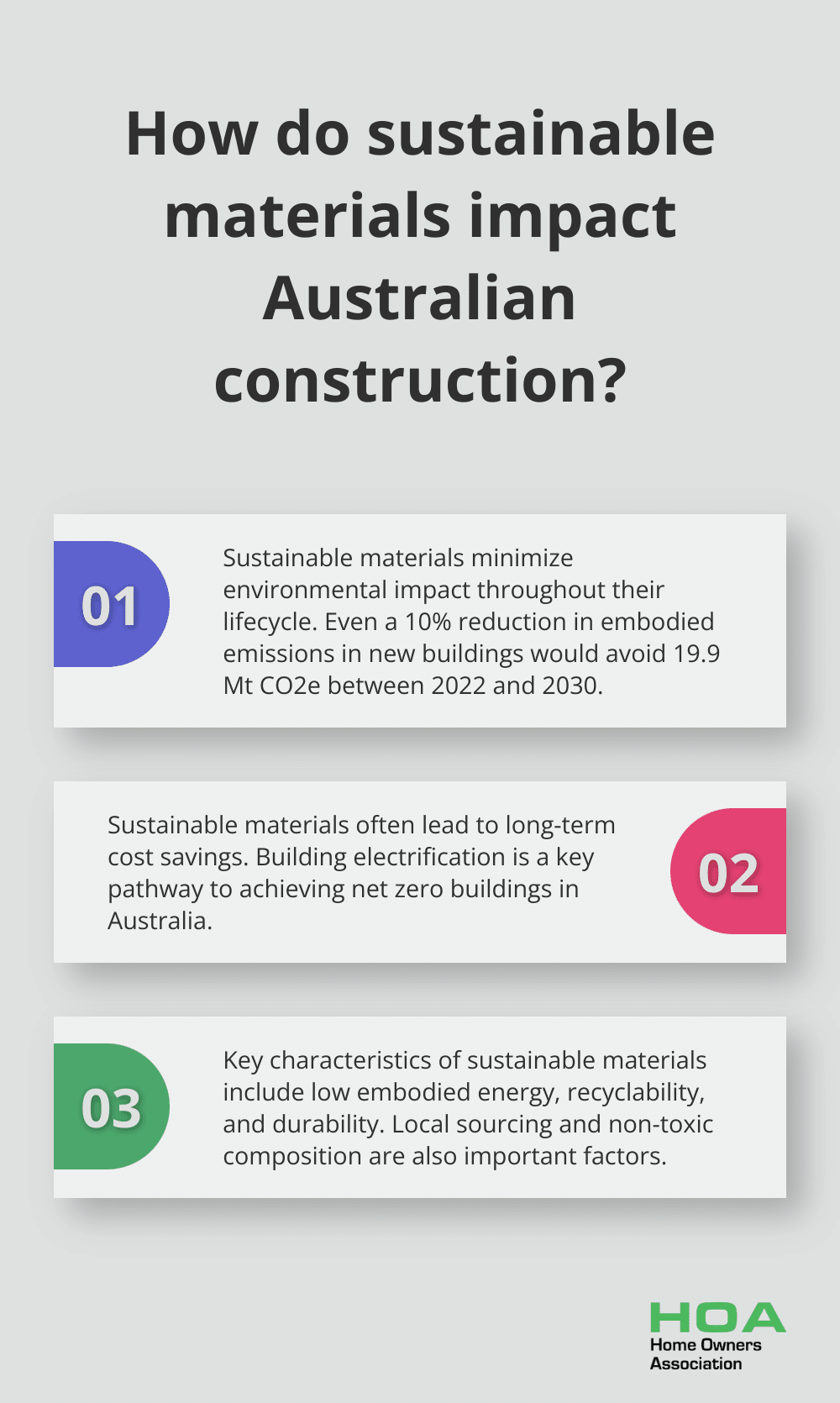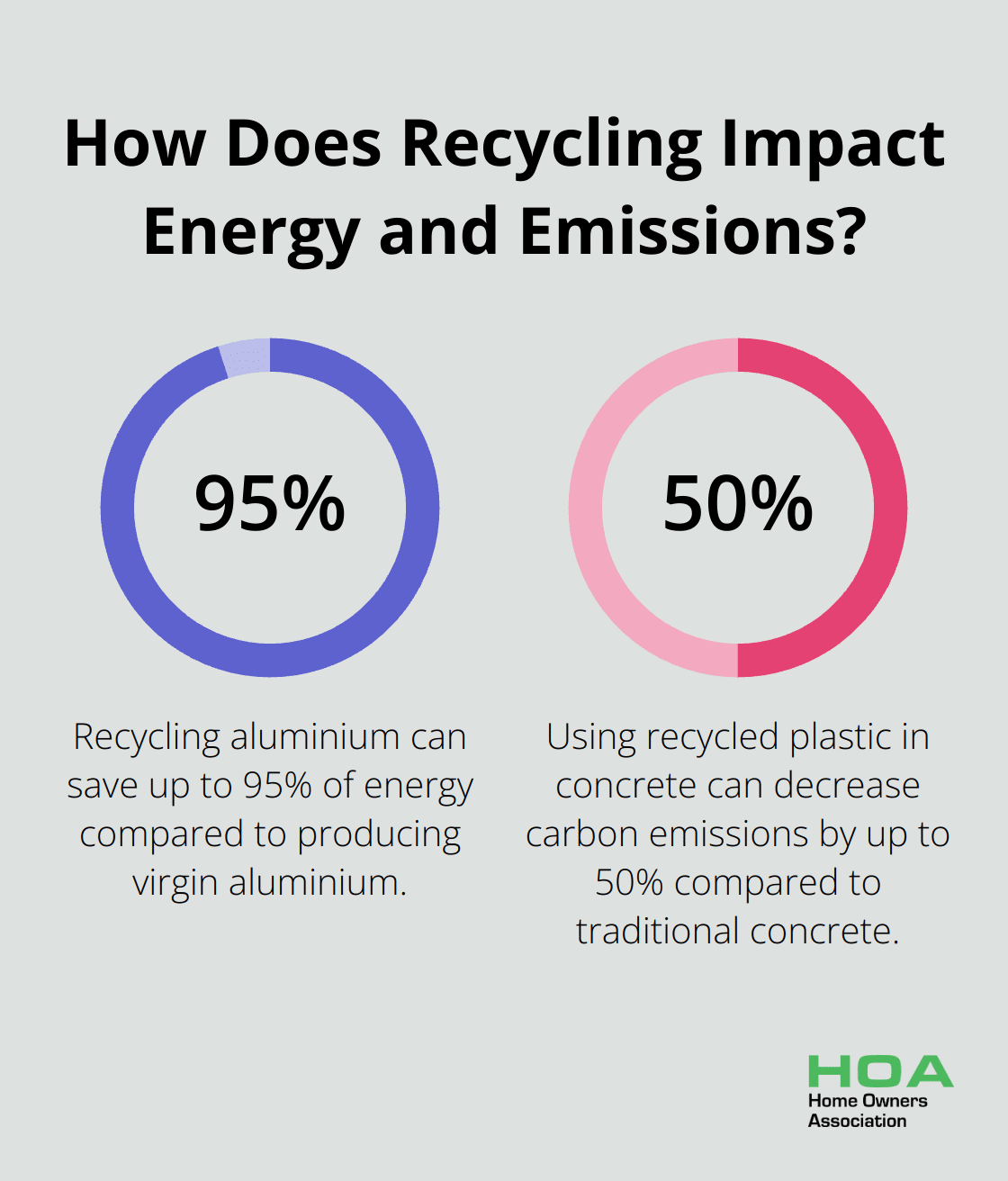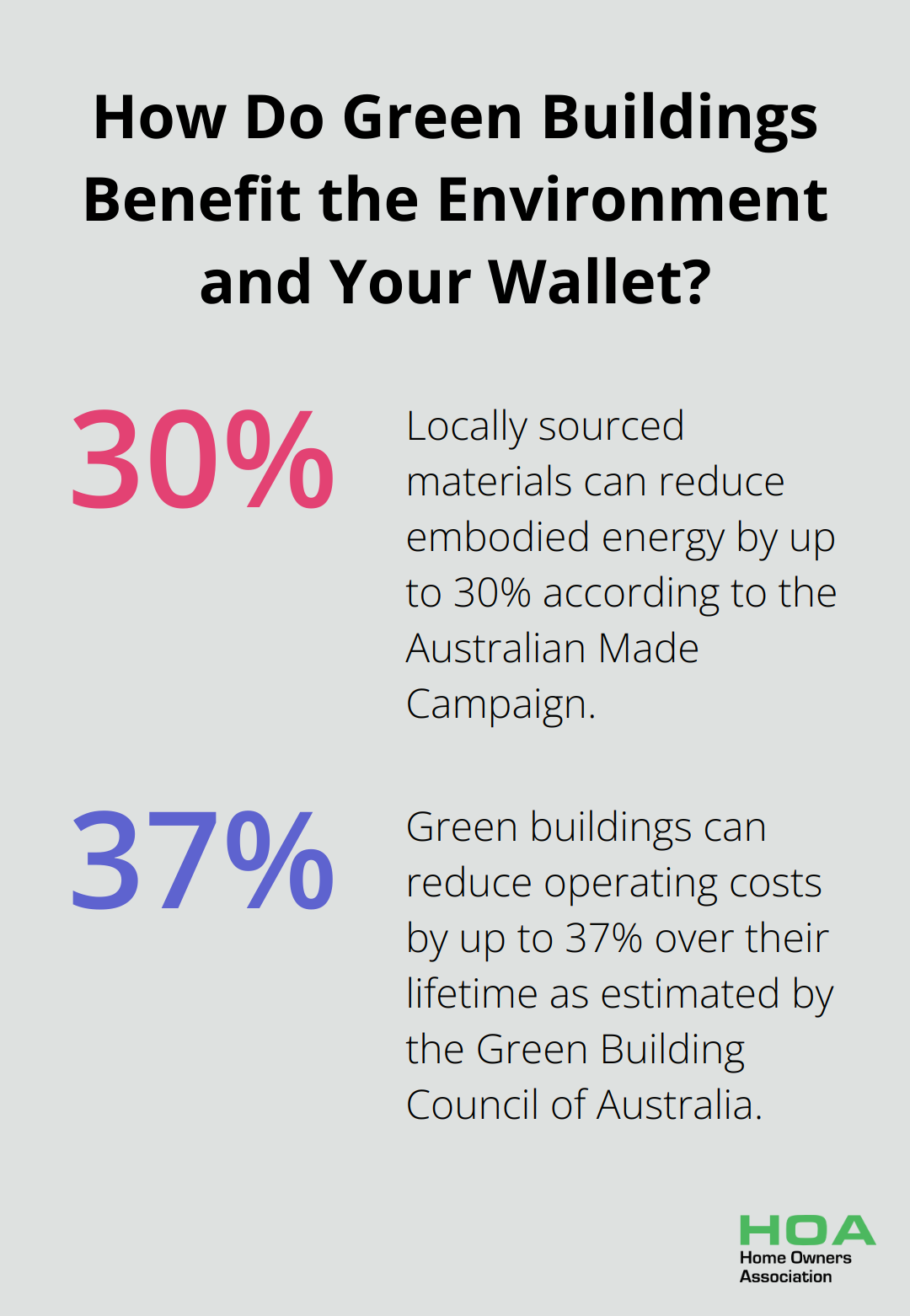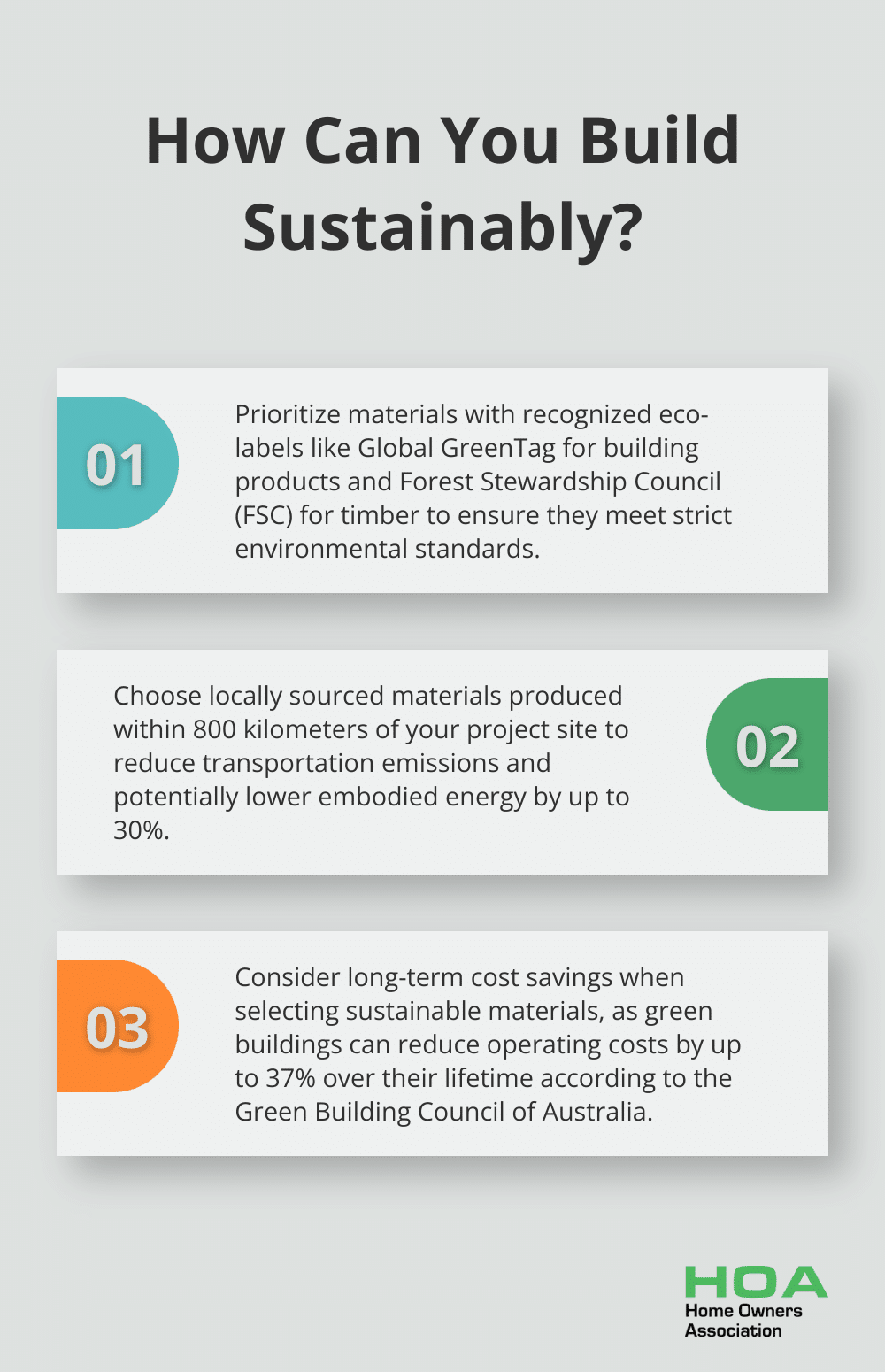
At Home Owners Association, we understand the growing importance of sustainable construction in Australia.
Australian building materials are evolving to meet environmental challenges and homeowner demands.
This guide will help you navigate the world of eco-friendly building options, from recycled steel to earth-based materials.
What Are Sustainable Building Materials?
Definition and Importance
Sustainable building materials form the foundation of eco-friendly construction in Australia. These materials minimize environmental impact throughout their lifecycle, from production to disposal. The use of sustainable materials in Australian construction is not just a trend; it’s a necessity. Even a 10% reduction in embodied emissions in new buildings would correspond to at least 19.9 Mt CO2e avoided between 2022 and 2030. Homeowners can significantly reduce this environmental footprint by choosing sustainable options.
Economic Benefits
Sustainable materials often lead to long-term cost savings. The Australian Sustainable Built Environment Council emphasizes the importance of building electrification as a key pathway to achieving net zero buildings. This economic advantage makes sustainable materials an attractive option for budget-conscious homeowners.
Key Characteristics
When selecting sustainable building materials, homeowners should look for these essential characteristics:
- Low embodied energy: Materials that require less energy to produce, transport, and install.
- Recyclability: Products that can be easily recycled at the end of their life cycle.
- Durability: Long-lasting materials that reduce the need for frequent replacements.
- Local sourcing: Materials produced nearby to reduce transportation emissions.
- Non-toxic composition: Free from harmful chemicals that could impact indoor air quality.
Trusted Certifications
To ensure the selection of genuinely sustainable materials, homeowners should look for recognized certifications. The Forest Stewardship Council (FSC) certification for timber products and the Global GreenTag for various building materials are reliable indicators of sustainability. These certifications provide assurance that the materials meet strict environmental standards.
Innovative Solutions
Innovation in sustainable materials advances rapidly. Cross-laminated timber (CLT) gains popularity as a carbon-negative alternative to concrete and steel. Similarly, hempcrete (made from the hemp plant) offers excellent insulation properties while absorbing significant CO2 during cultivation.

The understanding of sustainable building materials equips homeowners to make informed decisions for their construction or renovation projects. The next section will explore the top sustainable building materials available in Australia, providing a comprehensive guide for eco-conscious buyers.
Top Sustainable Building Materials in Australia
Australia’s construction industry embraces eco-friendly alternatives with open arms. The shift towards sustainable materials reduces environmental impact and offers long-term cost benefits. Let’s explore the top sustainable building materials making waves in the Australian market.
Recycled Steel and Aluminum
Recycled steel and aluminum lead the charge in sustainable construction. Recycling aluminium can save up to 95% of energy compared to producing virgin aluminium. Australian companies pioneer the use of electric arc furnaces, which can produce steel using up to 100% recycled content. This process conserves resources and significantly reduces carbon emissions.
Sustainably Sourced Timber
Timber remains a popular choice for Australian builders, but sustainability takes center stage. The Australian Forestry Standard (AFS) certification ensures timber sourcing from responsibly managed forests. Cross-laminated timber (CLT) gains traction as a sustainable alternative to concrete and steel. It offers remarkable strength and durability despite being lighter than traditional materials.
Innovative Flooring Solutions
Bamboo and cork flooring emerge as eco-friendly alternatives to traditional hardwood. Bamboo (which can grow up to 91 cm per day) is highly renewable. It’s also 25% harder than red oak, making it durable for high-traffic areas. Cork, harvested from the bark of cork oak trees without harm, offers natural insulation properties and biodegrades at the end of its lifecycle.
Recycled Glass and Plastic Products
The use of recycled glass and plastic in construction rises steadily. Recycled glass aggregates find their way into concrete mixes, reducing the need for sand extraction. CSIRO research indicates that using recycled plastic in concrete can decrease carbon emissions by up to 50% compared to traditional concrete. Some companies transform plastic waste into durable building products, such as decking and outdoor furniture.
Earth-Based Materials
Rammed earth and adobe make a comeback in modern Australian architecture. These materials offer excellent thermal mass properties, reducing heating and cooling costs. Earth-based materials also have minimal embodied energy and can be sourced locally, reducing transportation emissions.

The selection of sustainable materials for your project requires consideration of factors such as durability, local availability, and overall environmental impact. Home Owners Association members benefit from exclusive access to trade pricing on many of these sustainable options (making eco-friendly choices more affordable). Our next chapter will guide you through the process of choosing the right sustainable materials for your specific project needs.
How to Select the Right Sustainable Materials
Assess Your Project’s Unique Requirements
Start by defining your project’s specific needs. Consider the climate of your location, the intended use of the space, and local building regulations. If you’re building in a bushfire-prone area, you’ll need materials with high fire resistance ratings. The Building Code of Australia provides guidelines on material selection based on different climate zones and building types.
Prioritize Durability
Long-lasting materials reduce the need for replacements. The Green Building Council of Australia considers materials with a lifespan of 50 years or more highly durable. Recycled steel can last well over 100 years with proper maintenance, while sustainably sourced hardwoods can endure for decades.
Source Locally to Reduce Environmental Impact
Choose materials produced within 800 kilometers of your project site to minimize transportation emissions. Locally sourced materials can reduce embodied energy by up to 30% (according to the Australian Made Campaign). Many homeowners find success when they partner with local suppliers to source sustainable materials efficiently.
Balance Cost and Environmental Benefits
Some sustainable materials may have higher upfront costs but often lead to long-term savings. Green buildings can reduce operating costs by up to 37% over their lifetime (as estimated by the Green Building Council of Australia). When you evaluate costs, factor in energy efficiency, maintenance requirements, and potential increases in property value. Energy-efficient improvements can also qualify for tax deductions, allowing you to save on taxes while reducing energy bills.
Verify Certifications and Standards
Select materials with recognized eco-labels and certifications. The Global GreenTag certification (widely respected in Australia) covers a range of building products. For timber, the Forest Stewardship Council (FSC) certification ensures responsible forest management. These certifications provide assurance that the materials meet strict environmental and social standards.

Final Thoughts
The shift towards sustainable Australian building materials marks a significant step in the construction industry’s evolution. These eco-friendly options reduce environmental impact and offer long-term economic benefits for homeowners. Homeowners who choose materials with low embodied energy, high recyclability, and local sourcing contribute to a greener future while potentially increasing their property values.

Informed decision-making proves essential when homeowners select sustainable materials for their projects. Factors such as durability, climate suitability, and certifications ensure the best choice for homes and the environment. Some sustainable options may have higher upfront costs, but they often lead to substantial savings over time through increased energy efficiency and reduced maintenance needs.
We at Home Owners Association support Melbourne homeowners in their sustainable building endeavors. Our members receive exclusive access to trade pricing on many eco-friendly materials (making environmentally conscious choices more affordable). We provide expert guidance to help you navigate the world of sustainable construction, ensuring your project aligns with your values and local building regulations.





